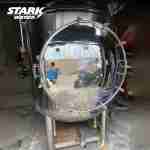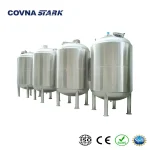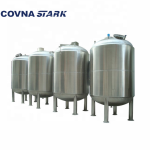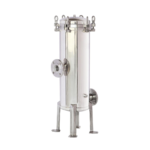Mixing Tank Design: Key Features That Improve Performance and Cleaning Efficiency
When it comes to industrial liquid processing, the performance and hygiene of a mixing tank are largely determined by its design—not just its capacity. Whether you’re working with food ingredients, pharmaceutical blends, or chemical solutions, a well-designed mixing tank can significantly reduce downtime, minimize contamination risk, and extend equipment life.
In this article, we’ll explore the critical design features that differentiate high-performance mixing tanks from the rest. From geometry and surface finishing to clean-in-place compatibility and outlet configuration, these elements can make or break your production efficiency and maintenance costs.
If you're looking for a stainless mixing tank that's easy to clean and built for export-grade industrial use, the insights below will help you make a smarter, long-term investment.
Tank Geometry Matters: Bottom Slope, Drainage, and Access
The geometry of a mixing tank is more than just a structural decision — it’s a critical factor in both product yield and sanitation. A properly sloped bottom facilitates complete drainage, reducing fluid retention that can lead to contamination or product loss. Conical or dish-bottom designs are especially effective in promoting natural flow toward the outlet, minimizing the need for manual cleaning.
For industrial use, bottom outlets are typically designed with a tri-clamp valve connection or sanitary ball valve, allowing for fast, hygienic discharges. Tanks that feature centered outlet ports at the lowest point of the slope improve overall CIP (clean-in-place) effectiveness.
Additionally, well-positioned manways and top access hatches allow maintenance teams to safely perform inspections or deep cleans when necessary. At STARK, our stainless mixing tanks are designed with both sloped geometry and optional high-leg structures for optimal drainage and easy floor cleaning.
Interior Surface Finish and Welding Quality
The internal finish of a mixing tank directly affects both product quality and ease of cleaning. A rough or uneven surface can harbor residues, promote bacterial growth, and complicate the CIP process. That’s why mirror polishing (Ra < 0.6μm) or fine brushed finishes are critical for hygienic applications such as food, dairy, or pharmaceuticals.
At STARK, we offer precision TIG welding across all internal seams, ensuring smooth, crevice-free joins that eliminate residue traps. For export-grade tanks, internal weld seams are fully ground and polished, conforming to GMP and FDA requirements when necessary.
When paired with corrosion-resistant stainless steel like SUS304 or SUS316L, a polished interior not only simplifies cleaning but also extends the tank’s operating life. These design upgrades make your mixing tank easier to sanitize and more resilient under frequent use.
Clean-In-Place (CIP) Compatibility
In modern industrial operations, downtime for manual tank cleaning is costly and often impractical. That’s why many high-performance stainless mixing tanks are designed with full CIP (Clean-In-Place) compatibility in mind. A well-designed tank should support thorough automated cleaning without requiring disassembly or manual access.
Key design elements that support CIP include spray balls or rotating nozzles at the tank’s top dome, properly sloped bottoms for rapid drainage, and strategically placed outlet valves. These features ensure that cleaning solutions can reach all internal surfaces and that wastewater is efficiently evacuated.
At STARK, we integrate optional CIP spray devices and sanitary drain valves into all our export-standard mixing tanks. Our designs help clients in food, beverage, and chemical industries reduce contamination risk and meet global hygiene standards with ease.
Material Matters: Choosing Between SUS304 and SUS316L
The grade of stainless steel you choose for your mixing tank significantly impacts its durability, corrosion resistance, and ease of cleaning. Two of the most common options are SUS304 and SUS316L—each with its strengths based on the target application.
SUS304 is a cost-effective and widely used grade, offering excellent general-purpose corrosion resistance and durability. It performs well in non-aggressive environments such as food processing, cosmetics, and light chemicals.
On the other hand, SUS316L includes molybdenum in its alloy, providing superior protection against chlorides and aggressive chemicals. It is the preferred choice for industries that deal with high-salinity solutions, acidic substances, or pharmaceutical-grade fluids.
STARK offers both options based on client needs. Our engineers work closely with global clients to determine the appropriate grade, ensuring regulatory compliance, hygiene assurance, and long service life under challenging operating conditions.
Mixing Tank Buying Checklist: What to Confirm Before You Order
Before finalizing a mixing tank purchase, especially for export-oriented industrial projects, it's essential to review a set of design and operational criteria. This not only ensures performance and hygiene compliance but also avoids costly retrofits or compatibility issues later.
- Material grade: SUS304 for general use, SUS316L for aggressive environments
- Tank capacity: Confirm exact volume (liters or gallons) and expansion space
- Bottom design: Sloped or conical for better drainage and CIP performance
- Outlet configuration: Type, size, and location of valves (e.g., tri-clamp)
- Surface finish: Mirror polish or brushed finish for hygienic handling
- CIP compatibility: Is spray ball or cleaning system included?
- Export readiness: Crating, documentation, certifications (CE, FDA where needed)
At STARK, our stainless mixing tanks are built with these criteria in mind. We support global OEMs, integrators, and plant operators with fully customized solutions designed for easy cleaning, efficient processing, and reliable export logistics.





